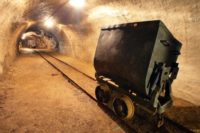'Unacceptable practices' at Virginia coal mine

 Poor ventilation was only one of the hazardous conditions found by Mine Safety and Health Administration (MSHA) inspectors during a special impact inspection last month at Mill Branch Coal Corp's Osaka Mine in Wise County, Virginia. The mine operators exposed workers to potential ignitions, fire and explosions, and the risk of developing black lung and other respiratory diseases – compliance issues which earned the mine 31 citations, one unwarrantable failure citation and wo withdrawal orders.
Poor ventilation was only one of the hazardous conditions found by Mine Safety and Health Administration (MSHA) inspectors during a special impact inspection last month at Mill Branch Coal Corp's Osaka Mine in Wise County, Virginia. The mine operators exposed workers to potential ignitions, fire and explosions, and the risk of developing black lung and other respiratory diseases – compliance issues which earned the mine 31 citations, one unwarrantable failure citation and wo withdrawal orders.
Not enough air
Osaka Mine is on a 15-day spot inspection interval for excessive methane liberation — the mine liberates 228,115 cubic feet of total methane during a 24-hour period. Inspectors issued an unwarrantable failure order for inadequate pre-shift examinations on the active working section for hazards that were extensive, obvious and existed for a period of time. Multiple foremen were present in the area on a daily basis. The operator did not comply with the approved ventilation plan; provide enough air to the continuous mining machine and idle headings; and adequately rock dust areas of the mine to maintain the incombustible content of coal dust, rock dust and other dust to at least 80 percent.
MSHA found the continuous mining machine cutting coal with a thick cloud suspension of coal and rock dust over the miner and shuttle-car operators. The operator also did not comply with the approved roof control plan requiring visible warning devices to prevent miners from receiving severe or fatal injuries by walking under unsupported roof. Coal dust suspended in the mine atmosphere is highly combustible and can cause an explosion.
High voltage, misaligned belts
The inspection team also issued a withdrawal order when the operator failed to conduct adequate on-shift examinations of a number of belts. Extensive violations included obstructed travel ways, unguarded high voltage transmission cable at a power center, accumulations of combustible materials in the form of black float coal dust, unsupported roof and ribs, improperly maintained belt conveyor and misaligned belts, and an inadequately maintained ventilation stopping.
"The conditions cited at the Osaka Mine are a clear example of why increased respirable dust sampling is needed to reign in these unacceptable practices exposing miners to black lung disease," said Joseph A. Main, assistant secretary of labor for mine safety and health. "We are already working to prepare for implementation of Phase II of the respirable dust rule that will require more extensive sampling of the mine air with new state-of-the-art sampling devices."
Impact inspections
Five impact inspections have been conducted at this mine under different ownership, operators and mine names since 2010. The Osaka citations were among 176 citations, eight orders and one safeguard issued by the MSHA during special impact inspections conducted at 13 coal mines and three metal and nonmetal mines in January.
Insufficient airflow at another mine
An inspection of FMC Corp's Westvaco mine in Sweetwater County, Wyoming, resulted in 30 citations and two orders — one for failure to maintain the minimum quantity of air at the mining face of an active working section. Further investigation revealed that the immediate area was mined and roof bolted with low airflow. Federal regulations require the mine operator to maintain 9,000 cubic feet per minute in longwall and continuous mining sections.
Inspectors issued a second order because auxiliary face fans recirculated air back to the working face area. MSHA's standard requires that, when auxiliary fan systems are used, such systems shall minimize recirculation and be maintained to provide ventilation air that effectively sweeps the working places.
Inspectors issued five citations because mining equipment was not being maintained in a permissible condition. Westvaco is a Category III mine, which applies to mines in which noncombustible ore is extracted and which liberate an explosive concentration of methane.
Begun in force in April 2010, the monthly inspections involve mines that merit increased agency attention and enforcement due to their poor compliance history or particular compliance concerns. The inspection details of two of the mines are listed below:
Since April 2010, MSHA has conducted 879 impact inspections and issued 13,756 citations, 1,229 orders and 56 safeguards.
Looking for a reprint of this article?
From high-res PDFs to custom plaques, order your copy today!




